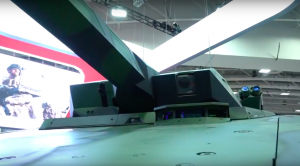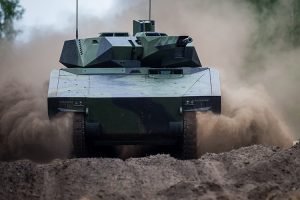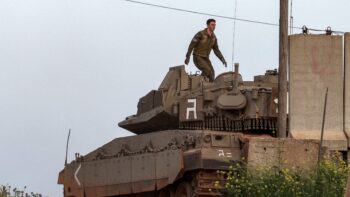UPDATED with Raytheon/Rheinmetall response to Army weight concerns AUSA: In a promising sign for the US Army’s Big Six modernization plan, not one but three different companies have invested their own money in full-up working vehicles for the Army’s Next Generation Combat Vehicle (NGCV) project:
- BAE Systems, which makes the current M2 Bradley Infantry Fighting Vehicle, a heavily armed and armored troop carrier that NGCV aims to replace (click here for our video tour of BAE’s CV90);
- General Dynamics, which makes both the massive M1 Abrams main battle tank and the (relatively) lightweight eight-wheel drive Stryker (click here for our video tour of GD’s NGCV offering); and
- an upstart team of Raytheon, best known for electronics, and Germany’s Rheinmetall, offering what they’re calling the Lynx — featured in the video above and detailed below.
Now, these aren’t prototypes, but the military equivalent of concept cars, designed to show off their manufacturers’ technology and get discussion going on what the final mass-produced product should like like. In this video, I walk you around the Lynx based on my background brief from Raytheon and Rheinmetall just hours before they officially rolled out their partnership here at AUSA.
Lynx: Revolutionary Or Overweight?
Rheinmetall’s shown off the Lynx at Eurosatory in Paris, but the partnership with Raytheon to go after the American NGCV program is new — and Raytheon brings a lot of high tech to the team, including their advanced (and long-in-development) Quick Kill Active Protection System to shoot down incoming anti-tank rockets and missiles. Another attractive feature for the Army is the Lynx has room for a full nine-man infantry squad in back, unlike either the current Bradley or the current incarnation of the General Dynamics Griffin.
UPDATE But putting armor around a passenger cabin that big adds a lot of weight, making the Lynx the heaviest of the three vehicles at almost 50 tons. Talking to reporters this morning, the Army’s NGCV director didn’t comment on specific vehicles, but he raised general concerns about all-new designs and about heavier vehicles — and Lynx is both the newest and heaviest of the three contender.
“We would like to field this vehicle by 2026,” Brig. Gen. Ross Coffman said. That puts a premium on proven systems. If, instead of adapting existing designs, a company tried designing something from scratch specifically for NGCV, he said, “it’d be great but i don’t know that’s doable.”
Coffman also doubted that any vehicle could carry a full nine-soldier squad and adequate armor without being too cumbersome for roads and bridges for many places he’s seen in Poland and Korea, two major potential warzones. “It gets really big and heavy,” he said, (and) the infrastructure doesn’t support a heavy vehicle.”
“We’re looking at everything as options,” Coffman continued, “(but) the idea is we have a smaller vehicle that is lighter, but survivable.” If the choice is between buying one heavier vehicle that can fit a full infantry squad or two lighter ones that can each carry half a squad, it sounds like the Army would go light. That puts a heavy burden on Rheinmetall and Raytheon to prove Lynx is not too heavy — or to start shaving tons.
Raytheon & Rheinmetall Respond
UPDATE 2 After the first update to this story came out, Rheinmetall and Raytheon experts gave me an extensive personal briefing on the Lynx, going into more detail than they had in earlier media engagements. Much of that detail is in my in-depth story comparing all three NGCV contenders, but it’s worth repeating the weight information here, because it goes a long way to addressing the Army’s concerns.

The Rheinmetall-Raytheon Lynx concept vehicle for the Army’s NGCV (Next Gen Combat Vehicle) program, on display at AUSA
In brief: Yes, the Lynx was the heaviest of the three vehicles as configured for display at AUSA. But all three vehicles have what’s called modular armor, allowing troops to add more protection or take some off depending on the mission.
Lynx has the widest range of the contenders. While on display at 46 US tons, that’s a compromise between protection and mobility. Lynx’s lightest configuration, stripped for air transport and light combat, comes in at just 35 tons, while its heaviest configuration, for high-intensity urban combat, maxes out at 55 tons.
By comparison, the General Dynamics Griffin III ranges from 38 tons (as shown on the floor) up to 50 — which means the Lynx can be lighter than Griffin’s lightest configuration or heavier than Griffin’s heaviest. BAE’s CV90 Mark IV, definitely the lightest of the three vehicles, ranges from 26 tons to 40, with an intermediate 35-ton configuration shown at AUSA.
To make that math easier to visualize, here’s a graph (we have more graphical comparisons in Monday’s piece):
Global interest in Iranian drones unlikely to wane despite failed Israel attack
Though virtually none of the estimated 170 drones Iran launched at Israel got through defenses, analysts told Breaking Defense there’s an eager market globally for Tehran’s relatively cheap, normally effective UAVs.





























